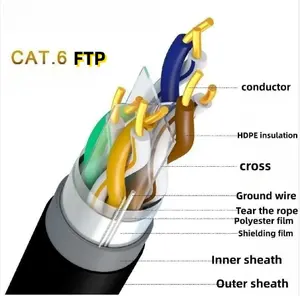## The Ultimate Comparison: Cat 6 vs 6a vs 6e - Which Ethernet Cable is Right for You?
When it comes to networking, choosing the right Ethernet cable can make a significant difference in your internet speed and overall performance. With variou……
When it comes to networking, choosing the right Ethernet cable can make a significant difference in your internet speed and overall performance. With various options available, understanding the differences between Cat 6, Cat 6a, and Cat 6e is crucial for making an informed decision. This comprehensive guide will delve into the specifications, advantages, and ideal use cases for each type of cable, helping you determine which one best suits your needs.
### Understanding Cat 6, Cat 6a, and Cat 6e
#### Cat 6
The Cat 6 cable, introduced in 2002, is designed to support data rates of up to 10 Gbps over short distances (up to 55 meters). It operates at a frequency of 250 MHz, making it suitable for most home and small office networking needs. The Cat 6 cable is backward compatible with Cat 5 and Cat 5e cables, allowing for easy upgrades without the need for complete system overhauls. Its enhanced performance over its predecessors makes it a popular choice for high-speed internet connections, online gaming, and HD video streaming.
#### Cat 6a

Launched in 2008, the Cat 6a cable is an augmented version of Cat 6, offering improved performance and capabilities. It supports data rates of up to 10 Gbps but can maintain this speed over longer distances of up to 100 meters. With a frequency of 500 MHz, Cat 6a provides better resistance to crosstalk and interference, making it ideal for environments with heavy data traffic. This cable is particularly beneficial for businesses and data centers that require high bandwidth and reliability for their operations.
#### Cat 6e
While the Cat 6e cable is not an official standard recognized by the Telecommunications Industry Association (TIA), it is often marketed as an enhanced version of Cat 6a. Cat 6e cables typically offer improved performance and can support higher frequencies, often up to 600 MHz. They are designed to provide even better crosstalk and interference resistance than Cat 6a, making them suitable for advanced networking applications and future-proofing your network infrastructure. However, since Cat 6e is not an official standard, it is essential to verify the specifications from manufacturers before making a purchase.
### Key Differences and Considerations

When comparing Cat 6 vs 6a vs 6e, several factors come into play:
1. **Speed and Bandwidth**: All three cables can support high-speed data transfer, but Cat 6a and Cat 6e excel in longer distances and higher frequencies, which may be crucial for certain applications.
2. **Distance**: If your setup requires running cables over longer distances, Cat 6a is the clear winner, with its ability to maintain 10 Gbps over 100 meters compared to Cat 6's 55 meters.
3. **Interference Resistance**: Cat 6a and Cat 6e offer superior resistance to crosstalk and external interference, making them more reliable in environments with multiple cables and devices.

4. **Cost**: Generally, Cat 6 cables are the most affordable option, while Cat 6a and Cat 6e tend to be pricier due to their enhanced capabilities. Consider your budget and specific networking needs when making a decision.
### Conclusion
In summary, the choice between Cat 6, Cat 6a, and Cat 6e ultimately depends on your specific requirements and budget. For most home users, Cat 6 offers ample performance for everyday tasks. However, for businesses or users with high-demand applications, investing in Cat 6a or Cat 6e may provide the necessary speed and reliability. By understanding the differences and advantages of each cable type, you can make an informed decision that will enhance your networking experience.